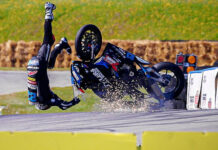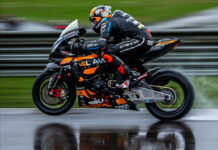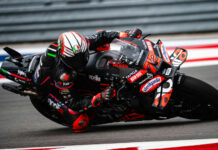CVMA Junior Cup Spec: Professional-Spec Club Racing
by Michael Gougis
The Chuckwalla Valley Motorcycle Association (CVMA), which races at Chuckwalla Valley Raceway, in Desert Center, California, plans to start a new racing class for the increasingly popular small-displacement sportbikes that will mirror the rules for the MotoAmerica AMA/FIM North American Road Racing Series Liqui Moly Junior Cup class.
Following the success of the FIM Supersport 300 World Championship class in 2017, MotoAmerica announced that it would replace the KTM RC Cup class with its own Junior Cup category for 2018. The class is designed as a showcase for lightly-modified lightweight sportbikes like the Kawasaki Ninja 400, the Yamaha YZF-R3 and the KTM RC 390. Although a wide variety of machines are eligible for the class, these three bikes dominate the field.
With widely differing displacements, weights, configurations and power outputs, MotoAmerica (and the FIM on the International level) have dictated a variety of weights and rev limits designed to balance the performance potential of the machines.
And that has led CVMA to decide to offer the Junior Cup Spec class, as the Southern California race organization has seen MotoAmerica do a solid job of equalizing the various machines and can simply adopt the ready-to-use National rules package.
“The truth is, they (MotoAmerica) are moving in the right direction,” says CVMA’s Micky Grana, whose daughter Emily Grana, made her MotoAmerica debut in the Junior Cup race at WeatherTech Raceway Laguna Seca earlier this year.
“We want to give the kids a place to get their feet wet, to practice, to learn how to race at the National level. And if we get the people racing in MotoAmerica to come here during the off-season, it’ll keep the momentum going and show the new kids how to go racing professionally.”
The plan for the new class is simple: Follow exactly what MotoAmerica is doing. That means the rev limits, minimum weights, and equipment requirements for the National series will be adopted for the new CVMA class.
“It will be the exact same, right down to the tires,” Grana says. “It will be more work for us, and it will require a little more commitment from the racers in this class. But it’s a different game at the National level, and they’re going to have to learn that.”
In addition to the normal tech inspection, participants in the Junior Cup Spec class at CVMA will be given the opportunity at tech to make sure that their machines adhere to the rev limits specified for each motorcycle. Initially, Grana says, most of the technical attention will be focused on making sure that bikes follow the rev limit guidelines. Motorcycles will be selected post-race for inspection to make sure that the machine’s ECU settings comply with the guidelines for that particular make. Grana says that if necessary, scales will be on hand to measure the weights of the motorcycles as well.
Grana also said that he has received assurances from Dunlop that pricing for the CVMA Junior Cup spec tire will be similar to, if not the same as, the MotoAmerica Junior Cup spec tire – which in both cases will be the Dunlop Sportmax Q3+.
Because of the geographic location of the track – set in the deserts of Southern California – the series runs during the winter months. This schedule makes it an ideal opportunity for racers to prepare for the National series, whether they are experienced racers ready to shake off the cobwebs of the off-season or new racers trying to be as ready as possible for a new endeavor.
And, Grana points out, racing at CVMA will offer those new racers the chance to meet others who are planning to participate in the MotoAmerica series. With the regulations for the class so strict, there is little secret about the machines, and there is no reason for competitors not to collaborate on transportation, shipping, or even pooling money for spare parts.
The new class is set to start at the September meeting of CVMA.
The move was met with approval from MotoAmerica officials. Chuck Aksland, Chief Operating Officer of MotoAmerica/KRAVE Group Partner, said, “If an organization wants to support the national series by having a feeder series into that class following the same rules, to us it’s a benefit for young riders to gain experience and for MotoAmerica in the long term.”






